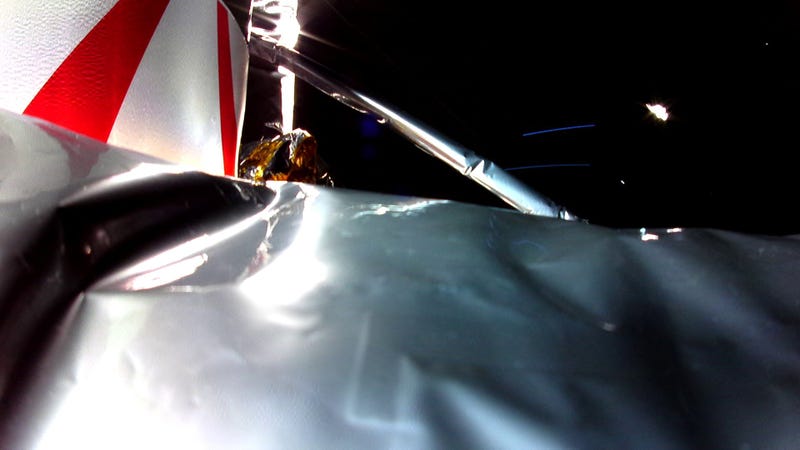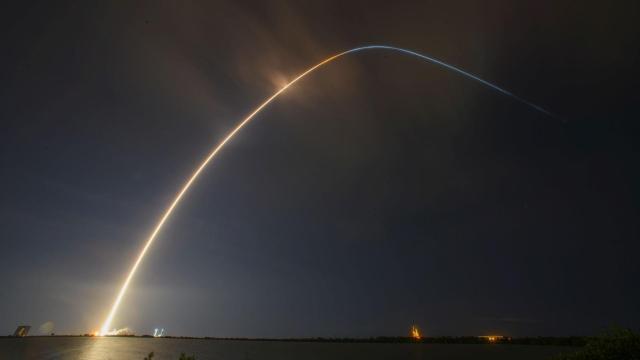Astrobotic, the team behind the Peregrine spacecraft, is urgently working to extract any possible value from its failing mission. This comes after a catastrophic propellant leak occurred just after yesterday’s launch, ending the spacecraft’s attempt to land on the Moon.
The 2,829-pound (1,283-kilogram) Peregrine lander reached space early yesterday, after the picturesque inaugural launch of United Launch Alliance’s Vulcan Centaur rocket. Following orbital insertion, Astrobotic, the Pittsburgh-based developer of Peregrine, was able to switch the vehicle on, including its thermal, propulsion, and power controllers. Soon thereafter, however, the spacecraft began to lose propellant at a critical rate, raising fears that Peregrine would not reach the lunar surface.
In a tweet earlier today, Astrobotic made it official, saying there is “no chance of a soft landing on the Moon” on account of the leak. The company is now in the midst of salvaging what it can from the mission, with less than 48 hours or power remaining.
Funded through NASA’s Commercial Lunar Payload Services initiative, Astrobotic is essentially trying to set up a cargo delivery service to the Moon, with Peregrine serving as the delivery van. The failing spacecraft is packed with 21 payloads, including five scientific instruments for NASA and the cremated remains of over 200 individuals, as chartered by space memorial companies Celestis and Elysium Space. To learn about the full range of items on board and their intended functions/purpose, check out our comprehensive report.

Peregrine will not land on the Moon, but it still has enough fuel to operate as a spacecraft. Astrobotic’s estimates suggest the vehicle has about 40 hours left of propellant; accordingly, the team “continues to work to find ways to extend Peregrine’s operational life” while “working payload and spacecraft tests and checkouts,” the company said.
The primary aim now is to navigate Peregrine as close to the Moon as possible before it loses the ability to point at the Sun and exhausts its power. As Astrobotic explained in a tweet yesterday, the “spacecraft’s battery is now fully charged, and we are using Peregrine’s existing power to perform as many payload and spacecraft operations as possible.” Astrobotic has not specified which payloads or operations it’s attempting to carry out with the Peregrine; however, considering the types of payloads involved, certain possibilities seem likely.
Peregrine currently carries two missions for space memorial company Celestis, one of which, the Enterprise Flight, was never intended for the Moon. The Enterprise Flight includes over 150 capsules filled with cremated remains, DNA samples, and messages from clients around the world, all destined for a voyage through interplanetary space.
This mission will be of interest to Star Trek fans, as it includes the partial remains of James Doohan, famed for his role as Chief Engineer Montgomery “Scotty” Scott; Majel Barrett-Roddenberry, who played Nurse Chapel and was the voice of the starship computer; Gene Roddenberry, the creator of Star Trek; and DeForest Kelley, known for his portrayal of Dr. Leonard “Bones” McCoy. The partial remains of science fiction author and futurist Arthur C. Clarke are also on board.
The Enterprise payload was intended to enter a solar orbit ranging from 150 million to 300 million miles into deep space, extending past the orbit of Mars. It’s not yet clear if Astrobotic can achieve this objective. However, keeping these remains in space for a protracted period, whether within or outside Peregrine, would seem to be a laudable objective under the circumstances.
Peregrine is also carrying vials of ashes, organized by Celestis and Elysium Space, that were bound for the lunar surface. However, since a lunar landing is no longer feasible, achieving a permanent presence in space serves as a fitting alternative. It’s important to note that these are only partial or symbolic remains, a precaution taken due to the inherent risk of failure in space missions.
Another likely goal will be to receive measurements from the German Aerospace Center’s M-42 radiation detector. The device, weighing just 250 grams, is designed to transmit radiation readings to ground controllers during the flight to the Moon. The data gathered during the journey could offer crucial insights into galactic cosmic radiation, which could subsequently improve astronaut safety measures during future Moon missions.
All five NASA payloads on board were meant to work on the lunar surface, so it’s not clear if they can be put to work in the limited time remaining. That said, future lunar missions are anticipated to carry duplicates of four of these NASA payloads, namely the Laser Retroreflector Array, Near-Infrared Volatile Spectrometer System, Neutron Spectrometer System, and Linear Energy Transfer Spectrometer (there’s currently no plan to include the Peregrine Ion-Trap Mass Spectrometer on a future mission).
We await further updates from Astrobotic to find out what it was able to accomplish during this intense time crunch. Peregrine won’t land on the Moon, but hopefully there will be at least some achievements or valuable data collected that can contribute to future space exploration efforts. We also remain hopeful for positive outcomes regarding the Celestis and Elysium missions.
